A review
Months ago while listening to a podcast, I heard a titled player mention how he studied games between engines to learn more about chess. To the interviewer, the such a notion was bizarre, but even I have noticed how some games between engines are quite amazing. If we consider the fact they are now much better than even the best humans, we can readily understand why there is something to gain from watching their games.
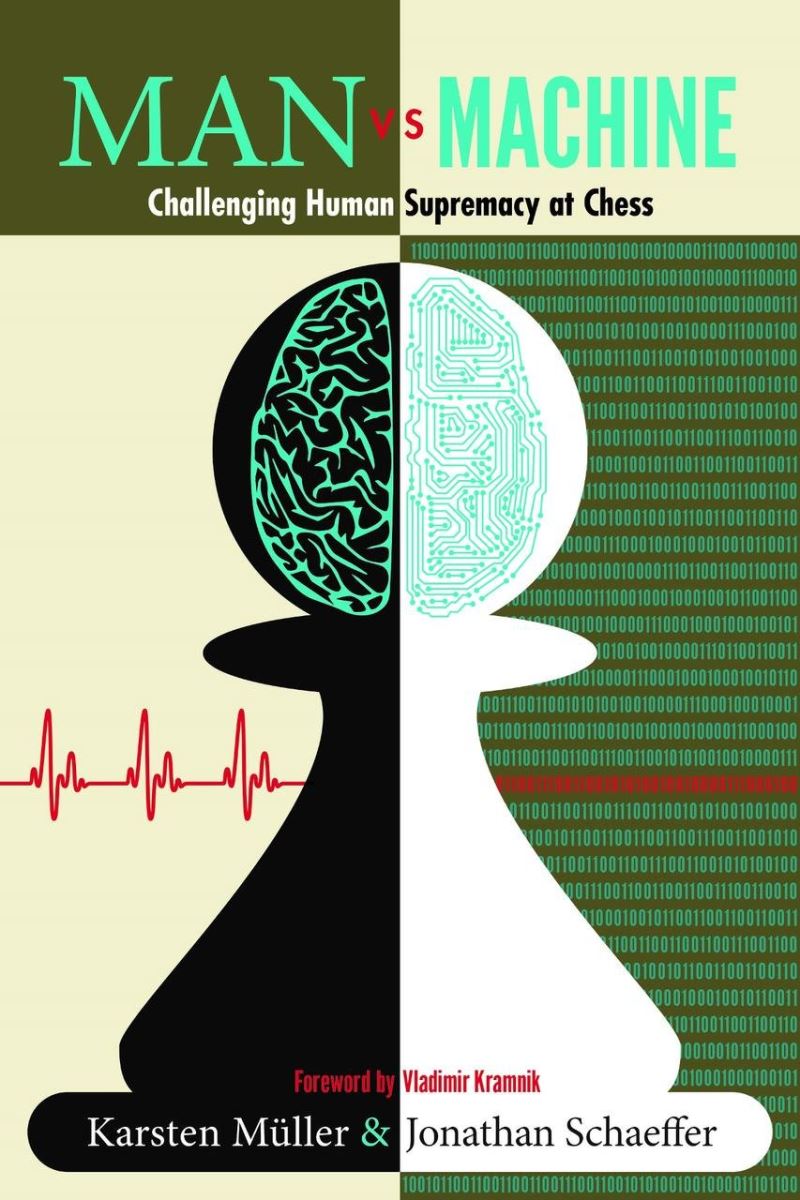 Now a new book, Man vs. Machine – Challenging Human Supremacy at Chess, by Karsten Müller & Jonathan Schaeffer and published by Russell Enterprises, enables us to follow the development, and improvement of chess programs step by step, year after year, through a multitude of annotated games. With each game, one can understand a little more about chess and the challenges that programmers had to overcome in order to create the artificial players which today are above and beyond us all.
Now a new book, Man vs. Machine – Challenging Human Supremacy at Chess, by Karsten Müller & Jonathan Schaeffer and published by Russell Enterprises, enables us to follow the development, and improvement of chess programs step by step, year after year, through a multitude of annotated games. With each game, one can understand a little more about chess and the challenges that programmers had to overcome in order to create the artificial players which today are above and beyond us all.
When at my local chess club I have the chance to speak with players of a variety of levels — some as low as 1500 — and what baffled me was the number of years they were playing chess. Most of the ones I've spoken with, had played chess for 20-30 years and yet never reached National Master level (2200 USCF), let alone approach the GM level (2500). Clearly, time alone didn't help them improve. The contrast to the chess programs is quite interesting: throughout the book, we can witness an ascending parabolic trajectory which boggles the mind. Yes, the hardware of the computers improved and that gave the chess programs an advantage in calculation compared to humans. But calculation in chess, while very important, is only part of the journey to improvement. In fact, there are many other factors in a game which can influence the final result. The work of programmers, joined by strong chess players, into create chess programs which would be able to factor in the evaluation of elements like doubled pawns (not always a disadvantage) or when to give up a pawn or other material to get a better position (today most engines are able to sacrifice material, but it wasn't always so), and of course many other aspects of a position. This, in my opinion, is one of the most amazing accomplishments of western civilization.
 Fritz 16 is looking forward to playing with you, and you're certain to have a great deal of fun with him too. Tense games and even well-fought victories await you with "Easy play" and "Assisted analysis" modes.
Fritz 16 is looking forward to playing with you, and you're certain to have a great deal of fun with him too. Tense games and even well-fought victories await you with "Easy play" and "Assisted analysis" modes.Coming finally to the review proper: The book is divided into four parts, which well describe the different historical development periods.
The first is given an evocative name: "Opening" and covers the years 1770 to 1956 and 1956 to 1969. It is quite interesting to read about the Turk, an automaton which also played Napoleon! Many readers will know that inside there was a human player (or several at different times), however, from the design, it was difficult to understand how the human could see the board, or stay inside for long periods. Or how no one was ever observed entering or exiting the device — it was a mystery. The others discuss the chess master Allgaier who was the man inside the Turk while playing against Napoleon Bonaparte. I cannot imagine how they kept the secret for over 50 years, and am now eager to learn more!
The second part is called the "middlegame" and begins with Chapter 3, covering the years 1970 to 1978 over 35 pages and twelve annotated games.
Chapter 4 covers the years 1979 to 1983. Helpfully, each chapter is given an Elo rating, signifying the strength the engines reached in this period.
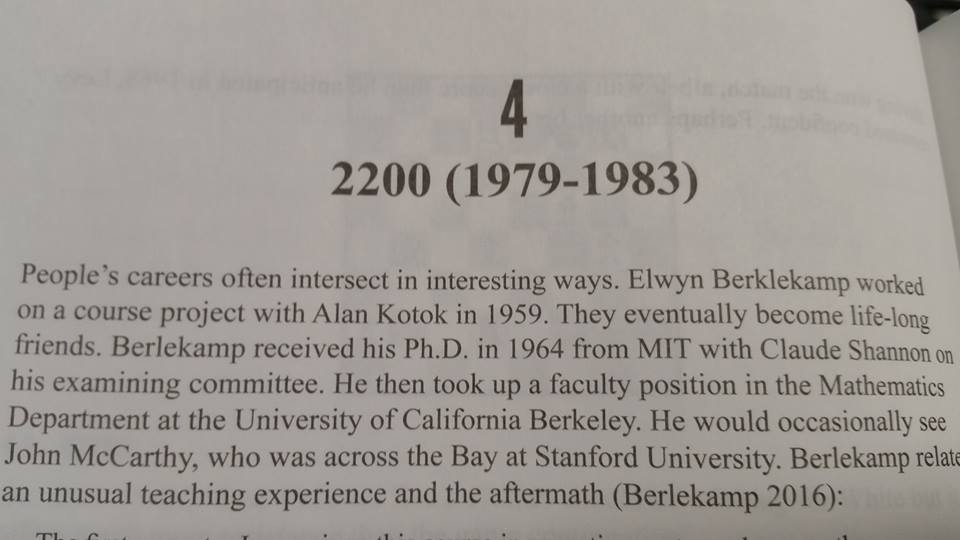
The beginning of chapter 4
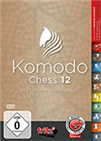 In computer chess there is no getting past Komodo, a two-time ICGA Computer World Chess Champion. Find out how Komodo can take your game to the next level!
In computer chess there is no getting past Komodo, a two-time ICGA Computer World Chess Champion. Find out how Komodo can take your game to the next level!Chapter 4 is 2200, the rating a National Master in the USA would have and this chapter is 20 pages including five games.
Chapter 5, 2500 (1984-1989), has twelve games, 33 pages, similar to Chapter 3 — this gives also an idea of how well annotated some of the games are, as they cover 2-3 pages each.
I feel the central part of the book — the middlegame — is quite interesting for the detailed description and explanation of the different discoveries programmers had, in the course of improving the quality of the chess programs. Jonathan Schaeffer did a fine job of explaining concepts like "Null Move-Searching" or "Singular Extension." But why is this central part of the book so important? Because one can find annotated the games of legends of the game, like Bent Larsen, Walter Browne, Boris Gulko and of course Garry Kasparov against Deep Blue.
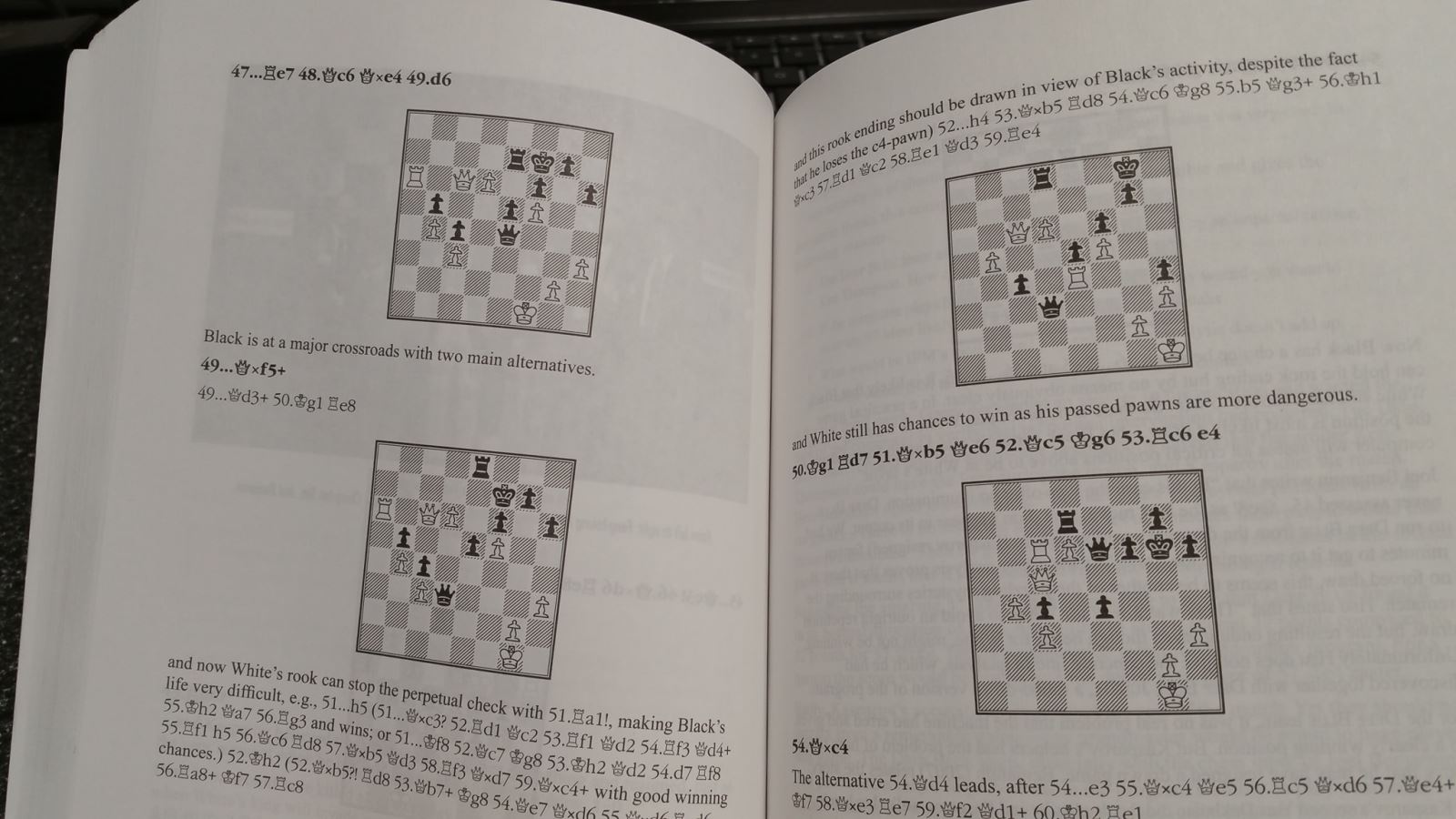
An example of an annotated game one can find inside the book
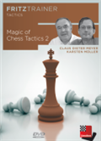 FM Claus Dieter Meyer has put under the microscope a comprehensive fund of topical and timeless games / fragments. On video Hamburg GM Dr. Karsten Müller has outlined corner points of Meyer's work and created 14 tests plus 10 interactive test sets.
FM Claus Dieter Meyer has put under the microscope a comprehensive fund of topical and timeless games / fragments. On video Hamburg GM Dr. Karsten Müller has outlined corner points of Meyer's work and created 14 tests plus 10 interactive test sets.I'd like to highlight one funny anecdote about the memory of chess players. On page 118, Hans Berliner, a former Correspondence World Champion, is quoted:
"In... '49 or '50 I became a master. And then I played on the U.S. Olympic team in 1952, and then in that period of time through '55, '56, '57, I was one of the top ten players in the country. And I played regularly in the U.S. invitational championship, and I even played the year Bobby Fisher [sic] won it for the first time. I finished fifth, and I drew with Bobby."
I wondered if this was a case of selective memory considering that Berliner played against Fischer four times — he lost three, but naturally, the game he remembered best was the one he drew!
In any case, while reading the book, I was interested to review the games, but I'm quite lazy about putting them in a database, so I asked my personal oracle, Megabase 2018, and found over 6,000 games of computers against humans!
The first one I examined, not necessarily from the book, is the following:

 Accompany FIDE Senior Trainer and IM Andrew Martin on this 60 mins video. You can learn a new opening system in 60 mins and start to play it with confidence on the very same day!
Accompany FIDE Senior Trainer and IM Andrew Martin on this 60 mins video. You can learn a new opening system in 60 mins and start to play it with confidence on the very same day!While perusing the games, sometimes I honed in on those included in the book and sometimes focused attention on champions who played against engines. I found some interesting games which also reveal the evolution of the machines. One amazing player who played extensively against the machines, defending humankind, is Bronstein — at least right up to the moment when he too succumbed! I reviewed all his games — many are in the book so I also enjoyed the annotations by GM Mueller. I'll add a small sample of Bronstein games because we should all be in awe of such a great player and how much his games can teach us.
After two easy wins, in which Bronstein shows his charming positional style from which arise the spell-binding attacks we remember most, in 1992 we see the rise of a colossus which totally smashed Bronstein: Deep Thought II.
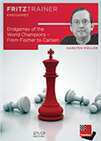 Let endgame expert Dr Karsten Müller show and explain the finesses of the world champions. Although they had different styles each and every one of them played the endgame exceptionally well, so take the opportunity to enjoy and learn from some of the best endgames in the history of chess.
Let endgame expert Dr Karsten Müller show and explain the finesses of the world champions. Although they had different styles each and every one of them played the endgame exceptionally well, so take the opportunity to enjoy and learn from some of the best endgames in the history of chess. I'd like to mention that, in the book, the strengths and weaknesses of the engines are well explained. For example, in Chapter 6, page 147 and the following pages. This is quite interesting because it can be connected to what I wrote in the beginning of the article, on how humans didn't progress in nearly the same manner as the engines. Yet such a breakdown can provide a mirror of sorts into our own strengths and weaknesses.
I'd like to mention that, in the book, the strengths and weaknesses of the engines are well explained. For example, in Chapter 6, page 147 and the following pages. This is quite interesting because it can be connected to what I wrote in the beginning of the article, on how humans didn't progress in nearly the same manner as the engines. Yet such a breakdown can provide a mirror of sorts into our own strengths and weaknesses.
But the real question for me — an active tournament player with over 80 tournament games a year is: can I improve by reading this book? Can I get an advantage from allocating my time to these games? My answer is a definite, "yes".
Sure, the goal of the book isn't chess improvement, but watching so many games through a span of decades really enlightened me — including about how humans changed thanks to engines. This point is worth emphasising: I think humans became better players because of their interaction with engines. And for "humans" I don't mean only the top GMs, who use engines professionally all year long alongside their trainers, but even young players.

I remember another podcast in which the stepfather of Hikaru Nakamura [pictured in 2001], FM Sunil Weeramatry [also a well-known scholastic trainer -Ed.] said Hikaru was playing against an engine all the time and filling up notebooks and more notebooks with games. Why? Because the young Hikaru had an amazing idea reflecting the typical naivety of youth. He would play his favourite opening lines against the engine and obviously would lose. Then he would ask the engine to play the same line, and he would play how the engine played against him! Back and forth. Discovering how he should continue for his next game against the engine. Clearly a very smart idea — especially considering it was just a kid who came up with it.
The final two parts of the book describe the modern period when engines moved beyond human ratings, and then the book ends with two appendices — one on the references and another of games, in which I counted over 70.
Pros and Cons
The quality of the research and the huge amount of games — most of them annotated — would be worth for McFarland, a publisher of large historical chess biographies — hardcovers and prices of at least USD $75! So, you see this book is a great value. I think the authors did a good job at balancing the history of a certain period, with illustrative games.
One small gripe: the book has been published with quite a small font which, for my ageing eyes is a pain. I understand the publisher's predicament, however, because, even so, the book is nearly 500 pages long. Still, I'd prefer a bigger font.
Final thoughts
When I saw this book I took it immediately, in part because of the co-author Karsten Mueller — famous for his endgame knowledge — and partly for the intriguing topic.
But I found the job of reviewing this book quite difficult. Why? Because there is so much material inside! Hundreds of games between some of the best human players, against so many different chess programs. Each chapter could be a book in itself! In fact, upon the Turk has spawned two large tomes, demonstrative that our knowledge of chess history can go quite deep. After reading Man vs Machine for over a month, I'm impressed by how Mueller and Schaeffer have elucidated the history and development of chess programs. Just as every player would benefit from going over the games of the world champions to improve, so too will these games prove to be immensely useful. It's also a great gift idea for those who don't know what to give to a chess player.
Man vs. Machine – Challenging Human Supremacy at Chess, by Karsten Müller & Jonathan Schaeffer. Published by Russell Enterprises – November 5, 2018; Paperback, 480 pages; Also available in Kindle and iBook editions; $34.95 Available at Chess Book dealers worldwide, including Google Books, Amazon (Paperback $34.95, Kindle $28.11), and from the European Distributor, New in Chess.
Links


















 Now a new book, Man vs. Machine – Challenging Human Supremacy at Chess, by Karsten Müller & Jonathan Schaeffer and published by Russell Enterprises, enables us to follow the development, and improvement of chess programs step by step, year after year, through a multitude of annotated games. With each game, one can understand a little more about chess and the challenges that programmers had to overcome in order to create the artificial players which today are above and beyond us all.
Now a new book, Man vs. Machine – Challenging Human Supremacy at Chess, by Karsten Müller & Jonathan Schaeffer and published by Russell Enterprises, enables us to follow the development, and improvement of chess programs step by step, year after year, through a multitude of annotated games. With each game, one can understand a little more about chess and the challenges that programmers had to overcome in order to create the artificial players which today are above and beyond us all.


 I'd like to mention that, in the book, the strengths and weaknesses of the engines are well explained. For example, in Chapter 6, page 147 and the following pages. This is quite interesting because it can be connected to what I wrote in the beginning of the article, on how humans didn't progress in nearly the same manner as the engines. Yet such a breakdown can provide a mirror of sorts into our own strengths and weaknesses.
I'd like to mention that, in the book, the strengths and weaknesses of the engines are well explained. For example, in Chapter 6, page 147 and the following pages. This is quite interesting because it can be connected to what I wrote in the beginning of the article, on how humans didn't progress in nearly the same manner as the engines. Yet such a breakdown can provide a mirror of sorts into our own strengths and weaknesses.





